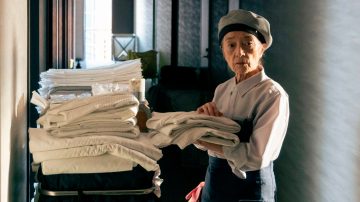
★★★★☆
Laura Poitras, the documentarist behind the Oscar-winning Citizenfour, is a filmmaker of great empathy, and it’s never been more obvious than in All The Beauty and The Bloodshed.
The film won The Golden Lion for Best Film at Venice International Film Festival in September 2022, a rare feat for a documentary. The film’s emotional compass and seemingly never-ending compassion clearly cut through the masses of glossy Hollywood films to impress the jury.
Awards aren’t, of course, everything, but it is important to note just how accessible Poitras’ new documentary is. The film tells the story of the artist and activist Nan Goldin, who has tirelessly campaigned against the Sackler family, who are largely responsible for the opioid crisis in America.

Credit: Altitude
Part of the film dives into Goldin’s story and history, documenting her rise in the art world. Goldin speaks of even the most difficult of topics – sex, abuse, death – candidly and with kindness. You get the sense that she is a no-nonsense kind of woman but also one with soft edges and a kind voice.
The documentary also thoroughly explains and highlights how the Sackler family have entangled themselves in the opioid crisis. We follow Goldin and her group P.A.I.N (Prescription Addiction Intervention Now) as they protest at various museums and art spaces.
What’s so arresting about Goldin is how calm she and her companions are. There is tangible anger here; they’re all survivors, but they’re not blinded by their rage. They’re justifiably furious, especially as they attend a virtual courtroom meeting with some of the Sackler family present. The Sacklers show no emotion, even as Goldin describes the effects of opioid addiction and the lives lost to it.
At times, Poitras directs her film almost like a thriller. She used a similar trick with the aforementioned Citizenfour; both films have a great sense of urgency and a rhythm that is often lacking in documentaries. There is real artistry here, and it could be argued that Goldin’s voice is just as authoritative as Poitras’ as a creator of this, but Poitras retains a distance between her subject and herself still, which allows her to explore Goldin’s persona a little more.

Credit: Altitude
Poitras has divided her film into distinct chapters, each of which starts with a slideshow of Goldin’s work, before often cutting to the protests Goldin spearheads. This juxtaposition of art and protest creates the powerful notion of protesting as art in itself.
Goldin also opens up about her home life. Her rebellious sister took her own life at a young age, and Goldin dedicates her own spirit to her sister, but it’s clear that a lot of her fight also comes from here. The title of the film comes from an old medical report from one of her sister’s doctors; she was described as someone who always witnessed “all the beauty and the bloodshed”, much like Goldin did in the 70s and 80s. After her parents tried to cover up her sister’s suicide, Goldin is clearly deeply disappointed in any system that tries to hide abuse and downplay their part in a tragedy.
All The Beauty and The Bloodshed is a sobering watch and a fascinating look into an artist’s work. It’s documentary filmmaking at its very best; compassionate, riveting and precise. Poitras’ work does not only explore Goldin’s art and activism but is an ode to it.
All The Beauty and The Bloodshed is in cinemas now.



